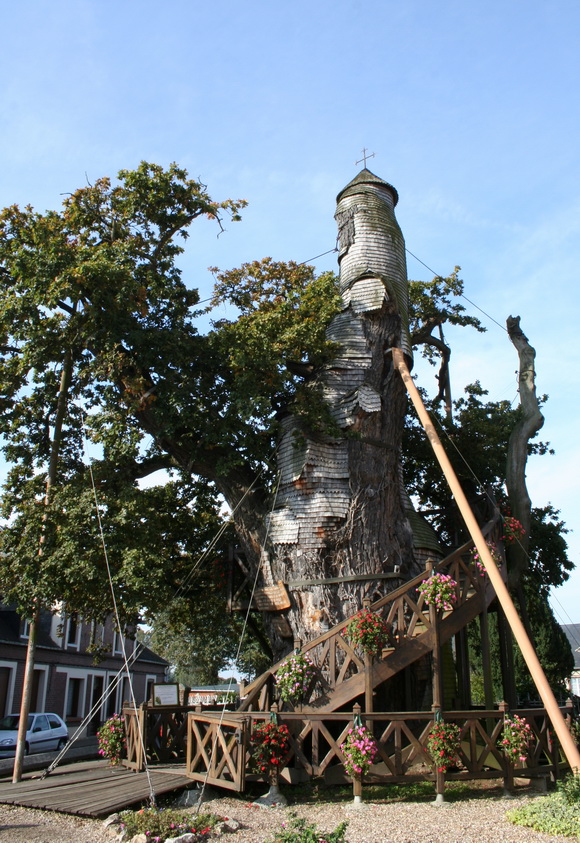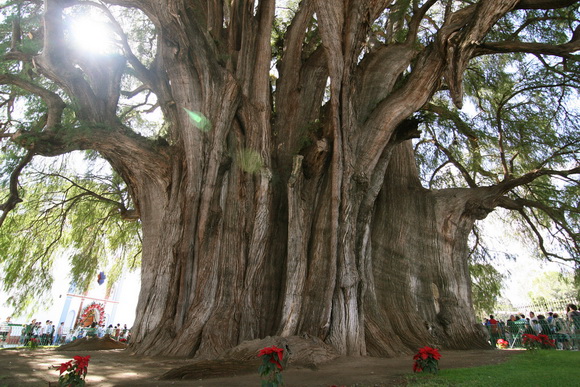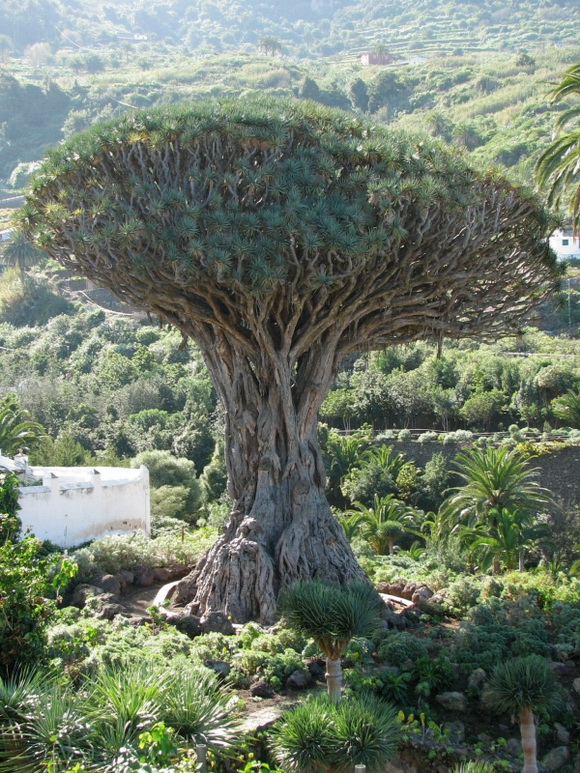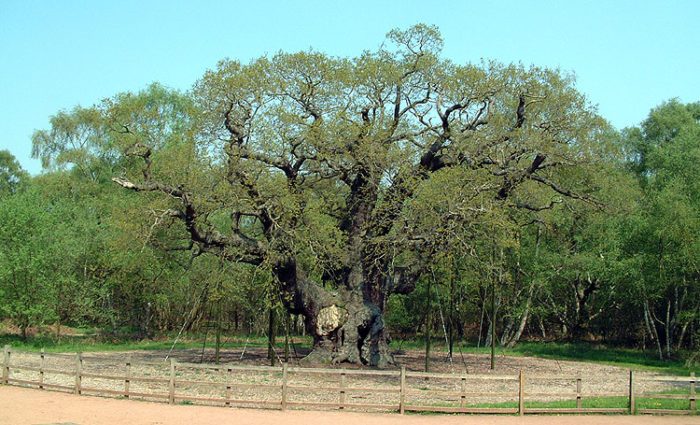Amazing trees exist all over the world.
Most of them have become tourist attractions because of their location, age, size, weird appearance, historical events or because of strange uses by humans.
Here a selection of my preferate ones!
Teapot Baobab, Madagascar
Teapot Baobab takes the form of bottle and also looks like teapot, which is why its name has teapot in it. This tree and the trees similar like this are located in Ifaty, Madagascar. The famed Teapot Baobab is around 1200 years old and has the capacity of storing more than 31,000 US gallons (117.000 litres) of water. It can show the endurance for severe drought conditions. [link, map]
Chandelier Tree, USA
The Chandelier Tree in Drive Thru Tree Park is a 315 foot (96 metre) tall coast redwood tree in Leggett, California with a 6 ft (1.83 m) wide by 6 ft 9 inch (2.06 m) high hole cut through its base to allow a car to drive through. The Chandelier Tree is a giant redwood located 175 mi (280 km) north of San Francisco on US 101. The massive tree had the ignoble fate of having a tunnel carved through its base more than 60 years ago and is now the centerpiece of a 200-acre grove of redwoods. [link1, link2, map]
Boab Prison Tree, Australia
The Boab Prison Tree is a large hollow Adansonia gregorii (Boab) tree just south of Derby,Western Australia. It is reputed to have been used in the 1890s as a lockup for Indigenous Australian prisoners on their way to Derby for sentencing. [link, map]
Cotton Tree, Sierra Leone
The Cotton Tree is a Ceiba pentandra (tropical tree), a historic symbol of Freetown, the capital city of Sierra Leone. According to legend, the “Cotton Tree” gained importance in 1792 when a group of former African American slaves settled the site of modern Freetown. Sierra Leonians regard it as the symbol of their capital city. Its exact age is unknown, but it is known to have existed in 1787. [link, map]
Lone Cypress Tree, USA
Chief among the scenic attractions at 17-Mile Drive (California) is the Lone Cypress Tree, a salt-pruned Monterey cypress (macrocarpa) tree which is the official symbol of Pebble Beach and a frequent fixture of television broadcasts from this area. [link, map]
Chêne Chapelle, France
The Chêne chapelle (Oak Chapel) is an oak tree located in Allouville-Bellefosse in Seine-Maritime, France. The oak tree is between 800 and 1,200 years old. It is 15m (50ft) high and its base has a circumference of 16m (53 ft). Within the tree are two small chapels, which were built there in 1669. Today the common oak is showing signs of age and stress, part of the 33-foot (10 m) trunk has died. [link1, link2, map]
Sunland Baobab, South Africa
Sunland Baobab is a well-known enormous baobab (Adansonia digitata) in South Africa. The tree is located on Sunland Farm (Platland Farm), near Modjadjiskloof (previously known as Duiwelskloof), Limpopo Province. The Sunland Big Baobab is renowned because in its hollowed trunk there is established a bar and a wine cellar. The tree has been carbon dated and is estimated to be around 1060 years old. [link, map]
Bartek, Poland
Bartek is an ancient oak tree in Poland. It grows in Zagnańsk near Kielce in the Świętokrzyskie Mountains. Its age, previously estimated at up to 1200 years, has recently been established to be 650–670 years, with a corer used to extract a sample for a ring count. King Casimir III (1310–1370) is known to have held court under Bartek. King Jan III Sobieski rested under the oak on his way back from the Battle of Vienna (1683). He reputedly hid a Turkish sabre, an arquebus and a bottle of wine inside it to commemorate the victory. The oak is still alive, but is in decline. [link, map]
Basket Tree, USA
This is the famous “Basket Tree” authored by Axel Erlandson (1884-1964), well-known Swedish American farmer, who shaped trees as a hobby, and opened a horticultural attraction in 1947 advertised as “See the World’s Strangest Trees Here,” and named “The Tree Circus.” Basket tree and all the other masterpieces of Axel Erlandson is located in Gilroy Gardens – a garden-themed family theme park in Gilroy, California. To create the “Basket Tree”, Erlandson planted six sycamore trees in a circle, topped them all at one foot, then approach-grafted them together one to another to form the diamond patterns. For the first 2.5 meters (8′) he left an opening at the top. This specimen today is featured as the centerpiece of Gilroy Gardens. [link, map]
Árbol del Tule, Mexico
El Árbol del Tule (Spanish for The Tree of Tule) is a tree located in the church grounds in the town center of Santa María del Tule in the Mexican state of Oaxaca, approximately 9 km (5.6 mi) east of the city of Oaxaca on the road to Mitla. It is a Montezuma cypress (Taxodium mucronatum), or ahuehuete (meaning “old man of the water” in the local language). It has the stoutest trunk of any tree in the world. In 2005, its trunk had a circumference of 36.2 m (119 ft), equating to a diameter of 11.62 m (38.1 ft). The tree is occasionally nicknamed the “Tree of Life” from all the images of animals that are reputedly visible in the tree’s gnarled trunk. [link, map]
The Great Banyan, India
The Great Banyan is a banyan tree (Ficus benghalensis) located in Acharya Jagadish Chandra Bose Indian Botanic Garden, Howrah, near Kolkata, India. It was the widest tree in the world in terms of the area of the canopy and is estimated to be about 200 to 250 years old. With its large number of aerial roots, The Great Banyan looks more like a forest than an individual tree. The area occupied by the tree is about 14500 square metres (about 1.5 hectares or 4 acres). The present crown of the tree has a circumference of about 1 kilometre (0.6mi) and the highest branch rises to about 25 m (82ft); it has at present 3300 aerial roots reaching down to the ground. [link, map]
Angel Oak, USA
This famous tree is a Southern live oak (Quercus virginiana) located in Angel Oak Park on Johns Island near Charleston, South Carolina. The Angel Oak Tree is estimated to be in excess of 500 years old, stands 66.5 ft (20 m) tall, measures 28 ft (8.5 m) in circumference, and produces shade that covers 17,200 square feet (1,600 m2). From tip to tip Its longest branch distance is 187 ft (57 m). The Angel Oak was damaged severely during Hurricane Hugo in 1989 but has since recovered. [link1, link2, map]
Dragon Tree at Icod, Spain
In Icod (a municipality on the island of Tenerife, in the Canary Islands), close to the Church of San Marcos, stands a famous dragon tree (22 m or 72 ft high, lower trunk diameter 10 m or 33 ft, estimated weight 70 t), which is reputed to be a thousand years old. It is the long-time symbol of Icod. [link]
Gloucester Tree, Australia
The Gloucester Tree is a giant karri tree (Eucalyptus) in the Gloucester National Park of Western Australia. At 72 metres (236 ft) in height, it is the world’s second tallest fire-lookout tree, and visitors can climb up to a platform in its upper branches for a spectacular view of the surrounding karri forest. Currently the climb is done by stepping on 153 spikes that spiral the tree. [link, map]
Ying Ke Pine, China
Welcoming Guest Pine (The Ying Ke Pine) is located on the east side of Jade Screen Peak, by Wenshu Cave. It’s about 10 meters (33 feet) high. The diameter of its trunk is 64cm (25 inches), and the diameter of its roots is 75 meters (246 feet). Half way up the trunk, two main lateral branchess, which are 7.6 meters (25 feet) long, stretch forwards. This pine is the representative example of Huangshan’s pines, and seems to act as an ambassador for the Yellow Mountains. [link, map]
Joshua Tree, USA
link
The iconic Joshua tree, the namesake of the California park (Joshua Tree National Park, USA), is actually a member of the lily family. Legend says that Mormon travelers named the tree after the biblical figure of Joshua. [link]
Tāne Mahuta
Tāne Mahuta is a giant kauri tree (Agathis australis) in the Waipoua Forest of Northland Region, New Zealand. Its age is unknown but is estimated to be between 1,250 and 2,500 years. It is the largest kauri known to stand today. Its Māori name means “Lord of the Forest” (see Tāne), from the name of a god in the Māori pantheon. According to the Maori creation myth, Tāne is the son of Ranginui the sky father and Papatuanuku the earth mother. Tāne separates his parents from their marital embrace until his father the sky is high above mother earth. Tāne then sets about clothing his mother with vegetation. The birds and the trees of the forest are regarded as Tāne’s children. [Link]
The Major Oak, Sherwood Forest UK
The Major Oak is a huge English oak tree near the village of Edwinstowe in the heart of Sherwood Forest, Nottinghamshire, England. According to local folklore, it was Robin Hood’s shelter where he and his merry men slept. It weighs an estimated 23 tons, has a girth of 33 feet (10 metres), and is about 800–1000 years old. In June 2002, the Tree Council designated the Major Oak one of fifty Great British Trees in recognition of its place in the national heritage. [link]


.jpg)











.jpg)














